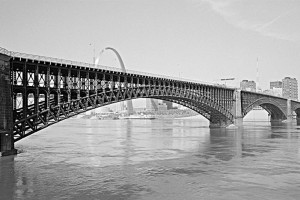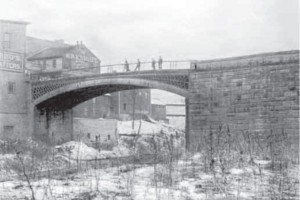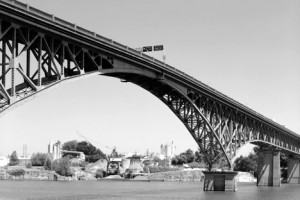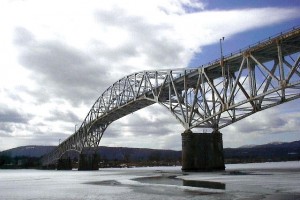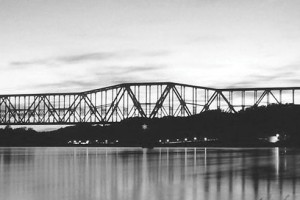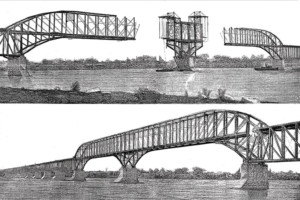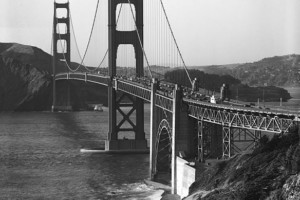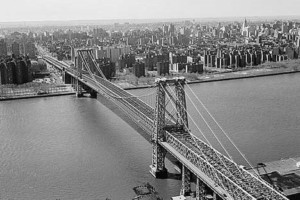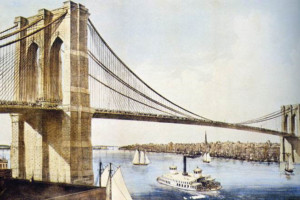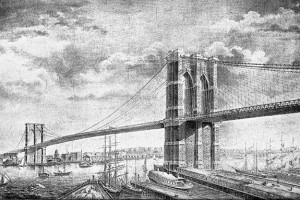The Eads Bridge was, perhaps, the best-known bridge of the 19th century after the Brooklyn Bridge. A bridge across the Mississippi River had been projected as early as 1839 when Charles Ellet Jr. (STRUCTURE, October 2006) proposed a 1,200-foot span suspension bridge. John A. Roebling (STRUCTURE, November 2006) also proposed a hybrid bridge, with a pier at mid-river, a short time later. …
Author Archives : Frank Griggs, Jr., Dist. M. ASCE, D. Eng., P.E., P.L.S.
About the author ⁄ Frank Griggs, Jr., Dist. M. ASCE, D. Eng., P.E., P.L.S.
Dr. Frank Griggs, Jr. specializes in the restoration of historic bridges, having restored many 19th Century cast and wrought iron bridges. He is now an Independent Consulting Engineer. (fgriggsjr@twc.com)
The First Cast Iron Bridge in the United States
Masonry arch bridges date from 1,300 BC, but it was the Romans who developed the form for bridges, aqueducts, and buildings. Many of them, like the Pont du Gard Aqueduct, circa 50 AD, still stand after almost two millennia. Cast iron arch bridges were built in England starting in 1779 with the Coalbrookdale Bridge across the Severn River, which still stands. Later, Thomas Telford built many cast iron arch bridges. His first was the Buildwas Bridge just upstream from the Coalbrookdale Bridge. Many of his bridges are still in service. …
Gustav Lindenthal, a leading proponent of continuous bridges, finished his Sciotoville Bridge (STRUCTURE, May 2017) in August 1917. In late 1922, a call went out to the largest and best-known engineers of the country to design three bridges (the Burnside, Ross Island, and Sellwood) across the Willamette River in Portland, Oregon. A group consisting of Ira Hedrick and Robert Kremers (Kremers was the local connection and had previously worked as an Engineer for the City) was awarded the contract to design the three bridges. …
Lake Champlain is 125 miles long and separates New York and Vermont for much of its length. Discovered by Samuel de Champlain in 1609, the lake at its widest is 14 miles. Between Chimney Point, Vermont, and Crown Point, New York, it narrows down to about 2,000 feet. For many years, the only way to cross the lake was by ferry. …
The Sciotoville Bridge, designed by Gustav Lindenthal (STRUCTURE, August 2010) over the Ohio River, is located about 90 miles upstream from Cincinnati. The Chesapeake and Ohio Railroad, in order to make Chicago accessible for its coal-carrying trains out of Kentucky, built a 30-mile line from its tracks in Edgington, Kentucky northerly across the Ohio River to Waverly where it connected with a line to Columbus, Ohio and then on to Chicago. …
Engineers knew for years that making spans continuous over piers could save a significant amount of wood, iron, or steel over that required for a series of simple span bridges. In fact, wooden bridge builders like Timothy Palmer, Theodore Burr, Ithiel Towne, Stephen Harriman Long, and others frequently built their spans continuous over the piers. They had only their intuition and experience to arrive at a design. …
The Golden Gate Bridge, designed by Joseph B. Strauss and Charles A. Ellis, is one of the best-known engineering structures. It was the longest suspension bridge in the world for many years, with a span of 4,200 feet. Proposals for a bridge across the Golden Gate started in 1869 and were reinvigorated almost 50 years later. In 1916, James Wilkins, a newspaperman but formerly a civil engineer, began his campaign to bridge the Gate. …
The Williamsburg Bridge across the East River in New York City is now over 100 years old. After a complete rehabilitation, it is still considered by some the “Ugly Duckling” of suspension bridges. In May 1883, the Brooklyn Bridge opened over the East River between New York City and Brooklyn. Even before the Brooklyn Bridge opened, however, residents of Williamsburg created an organization to pressure politicians for a new bridge. No real action resulted from this pressure. …
Washington A. Roebling assisted his father in the design of the bridge from March 1868, after he returned from his combination honeymoon and fact-finding trip to Europe. While in Europe, he visited Telford’s Menai Straits suspension bridge, Brunel’s Clifton suspension bridge, and many others. Washington toured the steel mills of England and Germany and learned all he could about pneumatic caissons. …
The Brooklyn Bridge, across the East River in New York City, is perhaps the most recognized bridge in the United States. As a result of David McCullough’s book The Great Bridge and Ken Burns’ American Stories – Brooklyn Bridge series, many engineers know some of the backstories of the bridge. Don Sayenga’s book, Washington Roebling’s Father, also clarified which Roebling, John or Washington, built the Bridge. Part 1 starts with the earliest plans for a bridge and runs up to John Roebling’s death in 1869 before the onset of construction. …

